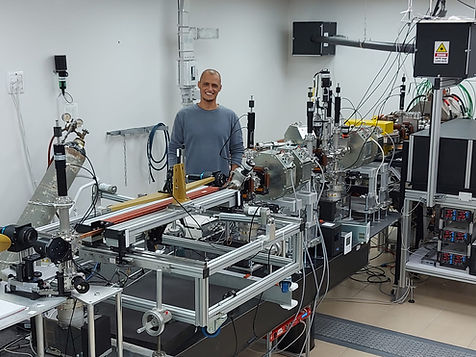
What is FEL?
Free Electron Laser (FEL) are the high power lasers which were the prime candidates to produce the intense laser beams intended to destroy attacking ballistic missiles in the "star wars" program. This veteran of the cold war has made a vocational conversion in the post cold war era. Presently it is being used mostly as a very flexible tunable source of coherent radiation for scientific, technological and medical research which is conducted in big user facilities.
At the present time there are more than 50 FEL facilities in operation and development all over the world - primarily in the U.S., Europe and Asia. FELs extract their radiation from the kinetic energy of an accelerated electron beam. Their operating wavelengths can range over a wide spectral range from microwaves to X-Ray, depending on the energy of the accelerator. The most advanced FEL projects produce coherent high brightness high intensity X-Ray radiation. No other kinds of laser can operate in this wavelength regime. Recent activity in this field is aimed to development of compact short wavelength coherent radiation sources based on laser acceleration.
Links:
https://www.fels-of-europe.eu/fel_facilities/non_european_facilities/facilities_worldwide/
http://sbfel3.ucsb.edu/www/vl_fel.html
The Israeli FEL Project
There are two main FEL projects in operation and under development in Israel, operated by a collaboration of Tel-Aviv University and Ariel University. The facilities are situated in the Center for Radiation Sources and Applications in Ariel.
1) A Tandem electrostatic accelerator mm-wave FEL
The Israeli Tandem FEL is one out of a few projects in the world which are based on electrostatic accelerators (http://sbfel3.ucsb.edu/www/vl_fel.html). Only these kinds of FEL can operate with a continuous wave (CW) or in a quasi-CW (long pulse) mode. All other FELs, are based on pulsed accelerators and can produce, therefore, only a pulsed waveform. Electrostatic Accelerator FELs (EA-FEL) have the potential for operating with high average power, high energy conversion efficiency and high spectral purity (narrow linewidth).
The accelerator development work and the subsequent EA-FEL project were established originaly in 1987 in the Weitzmann Institute by a Consortium of Tel-Aviv University, Rafael, Nuclear Research Center Negev, and Weizmann Institute. They were initially funded by the Israeli Ministry of Science, Ministry of Energy and Infrastructure, Ministry of Defense, the Israel Academy of Science, U.S.-Israel B.S.F. and the Meyer Foundation.
2) A Super-radiant THz FEL based on the ORGAD (Optically-driven RF Gun Accelerator Development) photocathode RF gun injector. This FEL is based on the concept of pre-bunched beam superradiance developed by A. Gover in the nineteen-nineties. This scheme enables high power emission at THz frequencies with a compact accelerator based on spontaneous superradiance emission of sub-picosecond electron bunches. The accelerator was developed as a collaboration project of Tel-Aviv University, Ariel University and UCLA Physics department. It was constructed by E. Dyunin and A. Nause in UCLA PBPL by E. Dyunin and A. Nause under the guidance of Prof. James Rosenzweig, and was installed in the Schlesinger Accelerator Center in Ariel in 2017. The superradiant FEL exhibited first light at the THz range in October 2022.
Read more about the Israeli FEL:
-
A. Nause, A. Friedman, Y. Vashdi, E. Farchi, A. Haj Yehye, A. Weinberg, L. Feigin, E. Magury, M. Gerasimov, P. Benishai “First Light at the Israeli THz Superradiant Free Electron Laser” CHILI conference, Tel Aviv, Israel. Dec. 2022
-
Gover, A., Ianconescu, R., Friedman, A., Emma, C., Sudar, N., Musumeci, P., & Pellegrini, C. (2019). Superradiant and stimulated-superradiant emission of bunched electron beams. Reviews of Modern Physics, 91(3), 035003.
-
Gover, A., & Pinhasi, Y. (2005). Electrostatic-accelerator free-electron lasers. In Electrostatic Accelerators (pp. 378-390). Springer, Berlin, Heidelberg.
-
Friedman, A., Gover, A., Kurizki, G., Ruschin, S., & Yariv, A. (1988). Spontaneous and stimulated emission from quasifree electrons. Reviews of modern physics, 60(2), 47
-
A. Gover, “Lasers: Free Electron Lasers” Encyclopedia of Modern Optics, Ed. R. D. Guenther, D. G. Steel and L. Bayvel, Elsevier, Oxford (2005); https://reader.elsevier.com/reader/sd/pii/B0123693950008447?token=9BD11A67F2A05EEFE9A5EC34E1A7A0EB80D853257DF368ACAE267F1E1019447D02F7F993917C1138786241296129096B&originRegion=eu-west-1&originCreation=20230111094609.1.





